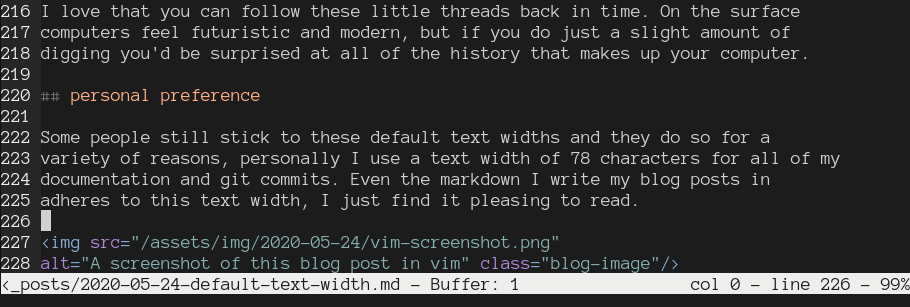Default Text Width
24 May 2020 | categories: blog
prev: Ruby Object Model | next: Control Characters
One of the things that I love about computers is even though we are hurtling into the future at an astounding speed, they hold onto to relics of the past. They have these idiosyncrasies that can only really be explained by looking into the past.
Δ who
skip tty2 2020-05-21 11:02 (tty2)
For example: Our terminals have the reference tty and tty stands for
teletypewriter, those screenless
beasts that people used to interact with computers before video terminals became
all the rage. The first UNIX operating system was written on a teletypewriter
using the line editor ed.
All these years later and our computers are still pretending to be a physical
terminal.
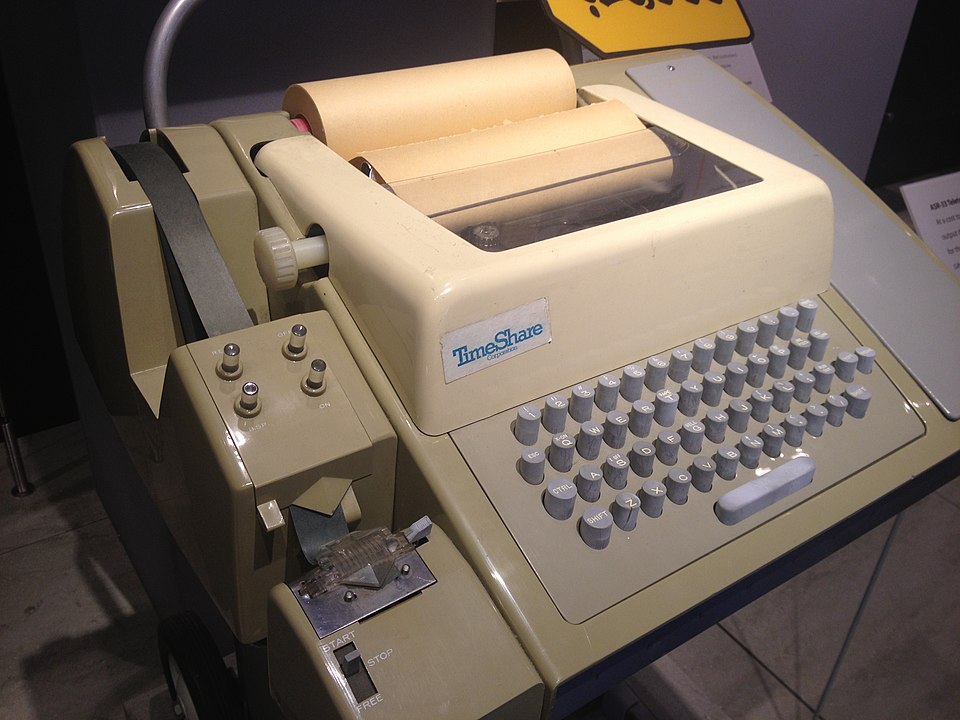
By ArnoldReinhold - Own work, CC BY-SA 3.0, Link
seeing patterns
I’ve been spending the past year or so trying to become more comfortable with the command line, that has involved a lot of reading and being introduced to programs I have never since needed to use. When I find out about a command I tend to open up the man pages to see what sort of options are available for me to use.
One thing that kept popping up in various manuals and settings was a default text width of 72-80 characters. I’m the sort of guy who sees a pattern like this and needs to know why.
pr
pr is a program for converting text files into a sensible format for printing,
in its man page it states the default page width is 72 characters.
-W, --page-width=PAGE_WIDTH
set page width to PAGE_WIDTH (72) characters always, truncate
lines, except -J option is set, no interference with -S or -s
vim
vim has a whole bunch of settings that need a text width and will default to
80 if one isn’t set.
6. Formatting text *formatting*
:[range]ce[nter] [width] *:ce* *:center*
Center lines in [range] between [width] columns
(default 'textwidth' or 80 when 'textwidth' is 0).
{not in Vi}
:[range]ri[ght] [width] *:ri* *:right*
Right-align lines in [range] at [width] columns
(default 'textwidth' or 80 when 'textwidth' is 0).
{not in Vi}
ps
ps is a command that produces a lot of output so some formatting options have
some information on default text width and wouldn’t you know it, our friend 80
makes another appearance.
args COMMAND command with all its arguments as a string.
....the output width is undefined (it may
be 80, unlimited, determined by the TERM
variable, and so on).
....
language style guides
Not only can this trend be spotted in command line tools, even style guides for prominent programming languages have a maximum desired line length.
- Python - 79
- Javascript - 80
- Ruby - 80
the list goes on
I could continue giving examples but I hope I’ve convinced you that there is a de facto standard here that programs fall back to. There are a couple of factors in history that have led to this standard text width range becoming so ubiquitous, pulling on one thread leads us down the path of punch cards and the other involves standard US letter sizes. Let’s start with letter sizes and the Dutch in the 1600s.
letters
The first part of this puzzle involves the US standard letter size of 8.5 inches by 11 inches, the reason for this specific size of letter dates back in the 1600s when the Dutch invented a two-sheet mold for papermaking. To maximise efficiency of making paper by hand they molded sheets 44 inches by 17 inches which could then be divided into eight 8.5 inches by 11 inches.
This letter size wasn’t the only letter size on the block, there were other sizes that people used if they were feeling adventurous such as the illustrious 8 inches by 10.5 inches.
Life was chaos in the paper world in the United States for a long time, multiple paper sizes were used in various departments across the country. We would need to jump forward to the 1980s to see President Ronald Reagan make 8.5 inches by 11 inches the official US standard letter size. It was actually a toss up between this size and a couple of others and involved committees being set up to hash that shit out, but I’ll let you research that on your own if you fancy reading about US paper size standards.
typewriters
Seeing as the letter size 8.5 inches by 11 inches has been kicking around since the 1600s it’s no surprise to find that it had a direct effect on the amount of characters per line that a person could type. Typewriters are physical machines that have a fixed character size, this isn’t like software today where you can change the font size to your liking, you were stuck with what the machine was capable of.
Without adding a margin most typewriters could fit between 85 and 102 characters on a line, this would vary depending on the font size the machine used and generally they fell in the range of 10 to 12 characters per inch. Writing letters all the way to the edge of the paper isn’t ideal, only a madman would do such a thing, so it was common to leave a margin of around 1 inch on either side. Let’s do some quick math here:
- 2 * 1 inch margin = 2 inches
- 2 * 10 characters per inch = 20 characters
- 20 characters - upper limit of line (say 95) = 75 characters per line
Here is a type writer that can fit 87 characters per line, check the ruler along the carriage.
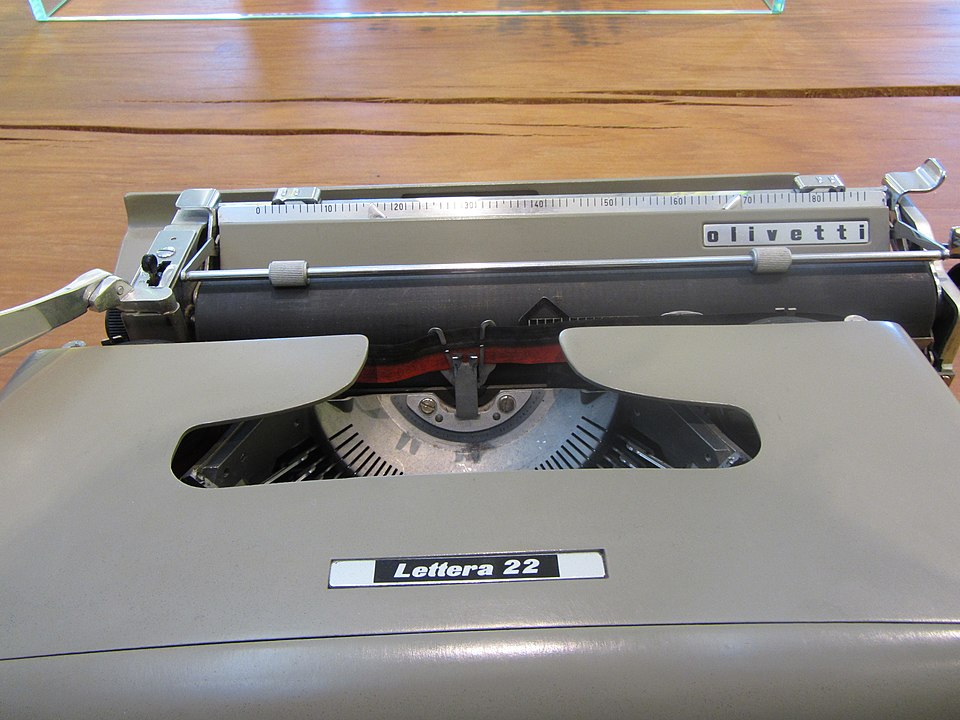
By Pava - Own work, CC BY-SA 3.0 it, Link
Going just off standard paper sizes and the fact machinery was build around this standard it’s easy to see why it had a profound effect on how computers turned out, even as printers were invented they were constrained by the physical limitations of their parts so the characters per line limit came along for the ride.
punch cards
The other side of this tale involved punch card computing and a man who had a fantastic moustache, Herman Hollerith. Hollerith is credited with inventing a machine that could read input from holes punched on a card, this machinery was used during the 1890 US Census.
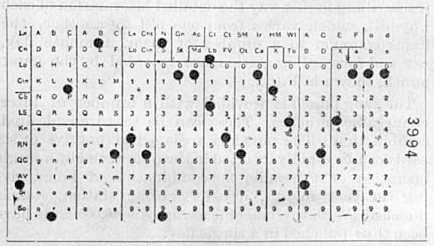
By Herman Hollerith - Railroad Gazette, Public Domain, Link
Hollerith had wanted there to be an array of card sizes for a variety of uses but said that 3 inches by 5.5 inches “would be sufficient for all ordinary purposes”. At some point over the coming years the standard card size grew to 3.25 inches by 7.26 inches.
IBM
Hollerith founded a company called Tabulating Machine Company in 1896, which eventually ended up being made part of a company called Computing-Tabulating-Recording Company (CTR) in 1911, which itself was later renamed to International Business Machines Corporation (IBM) in 1924.
By the time we get to the 1920s people were itching to get more holes in these cards to hold more data, up until then these punch cards needed round holes and would only hold 45 columns. Later designs changed the hole to be rectangular enabling up to 80 columns to fit on the card, the size of the card stayed the same at 3.25 inches by 7.26 inches.
to the future
I think it goes without saying that IBM did quite well for itself, today we consider it one of the leading technology companies. They reached this status through innovation, they didn’t rest on their punch card laurels, with technology rapidly advancing through the 20th century the company iterated on computer designs with the purpose of reading and handling data that was input using punch cards.
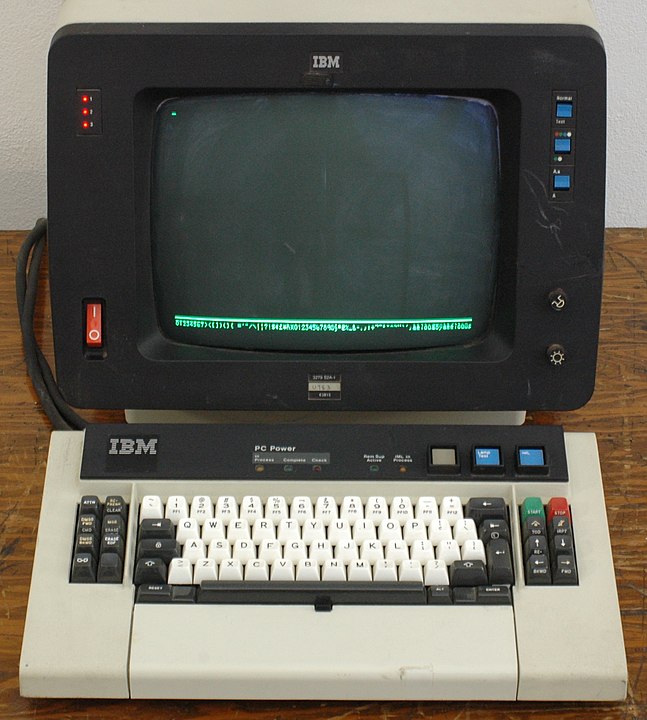
By Retro-Computing Society of Rhode Island - Own work, CC BY-SA 3.0, Link
The initial terminals for computers dealing with punch cards had an 80 character limit per line precisely due to the constraint of the punch card, however this trait continued on as more general purpose terminals were created, like the IBM 3279 pictured above. This screen size trend didn’t just happen with IBM, other companies who created computer terminals followed suit.
present day
Those two quirks of history, standardised letter sizes and punch card tabulation, have led to this default text width being found pretty much everywhere you look when it comes to computers and formatting. Even though earlier constraints are no longer a problem: our printers are capable of printing fonts of any size, our screens have crazy resolutions, and we generally don’t need to make much use of punch cards in our day-to-day lives.
I love that you can follow these little threads back in time. On the surface computers feel futuristic and modern, but if you do just a slight amount of digging you’d be surprised at all of the history that makes up your computer.
personal preference
Some people still stick to these default text widths and they do so for a variety of reasons, personally I use a text width of 78 characters for all of my documentation and git commits. Even the markdown I write my blog posts in adheres to this text width, I just find it pleasing to read.
